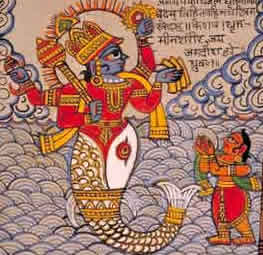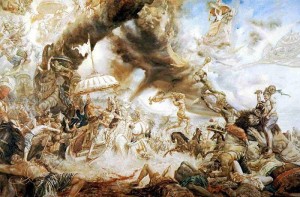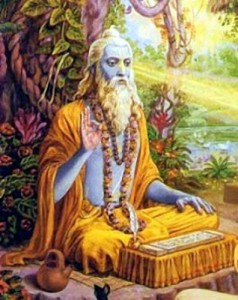The Puranas are stories which carry a perennial message of great importance in spiritual life. And the impact of the Puranic literature particularly on the Hindu Society, life and values is immense. Further it provides guidelines and instructions to man with regard to specific code of behaviour (Swadharma) and also supplies a general code of conduct.
In other words, the Puranic literature provides a strong and broad basis for human development, inculcating such Universal values containing virtues like non-violence (Ahimsa), truthfulness (Satyam), control of body (Dama), and control of mind (Shama), compassion (Daya), charity (Danam) and cleanliness (Shoucham), austerity (Tapa) and wisdom (Jnanam), they also give instructions on specific behaviour pattern of each individual depending upon his life style, vocation and inclination. (Varna, Ashrama and Dharma). Thus Puranas serve a very practical purpose in bringing order and meaning into the individual and social life in the Hindu Society.
Vedic Symbolism
All the Puranas are an attempt to convey a mystical message in a symbolic language. As a matter of fact, the source of inspiration for such an approach is the very Vedas. Vedas which are themselves mystical and symbolic.
The Ten incarnations (‘Dashavatar’) is a Puranic way of symbolizing the eternal drama that is going on within every human mind that the Almighty always comes to the aid of the pious against the wicked.
Concept of avatar
 The Lord Himself expounds the secret of His incarnation to his close devotee and friend Arjuna: ‘Whenever there is a decay of righteousness and rise of unrighteousness, then I manifest myself’.
The Lord Himself expounds the secret of His incarnation to his close devotee and friend Arjuna: ‘Whenever there is a decay of righteousness and rise of unrighteousness, then I manifest myself’.
‘For the protection of the virtuous and for the destruction of the wicked and for the establishment of Dharma, I am born in every age’ (The Gita Ch IV 7-8).
When there is a moral or ethical crisis on earth and when the existing noble values are disregarded the Lord comes (takes an, Avatara) upon this earth to set the matters right. He sets before Himself the task of uprooting ‘adharma’ and establishing ‘dharma’ on firm foundations and achieves it as He wills. The message of each Avatara is for the evolution of mankind.
What is dharma?
Dharma connotes duty, virtue, righteousness, religion, charity all at once; in other words, that which helps us to morally sustain ourselves in this world is Dharma.
An interesting anecdote is narrated in one of the Epics pointing out the importance and efficiency of Dharma. The Mahabharatha contains a story about a butcher, Dharmavyadha who carried on his duties without any attachment and who dutifully served this parents. As a result of this, he was recognized as a great follower of Dharma.
A certain celibate (Brahmachari) by virtue of his penance, acquired some supernatural powers. A bird innocently put its droppings on his head. The celibate looked up enraged and the bird was reduced to ashes. Later he went to a house begging for food. The lady of the house asked him to wait as she was serving her husband. The infuriated celibate started shouting at the lady. But the lady calmly replied, “I am no bird to be burnt up by you”. The Brahmachari was very much surprised that the lady knew about the incident. Humbled, he sought her guidance. The lady directed him to the butcher. The latter gave detailed instructions about service to parents, which was particularly pertinent to the celibate, who had completely ignored his obligations to his parents. The butcher was blessed by the Lord. It therefore follows that a strict and meticulous observer of Dharma (his duty) need not be afraid of anybody (or even death). For treading the path of devotion and Dharma no specific qualifications are needed except faith in the word of the scriptures.
The Puranas are very ancient, yet very much modern. In this sense, they are said to have a perennial significance. As Sri Aurobindo shows, ‘You meet yourself and your own personality factors over and over again in the Puranas as it happened in the Vedas. It is this personal encounter with oneself that makes the Puranas eternally new’. When we understand the deeper meaning of the Puranas, we find that it is pure Vedanta.
The Philosophical Interpretation
 In Kenopanishad, the third chapter contains a story which is a symbolic representation of the Upanishadic Truth. It attempts to objectify the philosophical and subjective narrations.
In Kenopanishad, the third chapter contains a story which is a symbolic representation of the Upanishadic Truth. It attempts to objectify the philosophical and subjective narrations.
The gods (Devas) once won a victory over the demons (Asuras), but blinded by their success they started gloating over their achievements. In order to teach them a lesson, the Absolute Truth, gave a vision to the Gods in the form of an enchanting Yaksha.
The gods requested Lord Agni and asked him to ascertain the identity of the spirit. Lord Agni hastened towards the spirit boastfully declaring that he is the Lord of Fire. The spirit placed a piece of grass in front of Agni and asked him to reduce it to ashes if he could.
Lord Agni could not even warm the blade of grass and thus complete accepted his complete failure.
Then for the second time, Lord Vayu was chosen to enquire and ascertain the identity of the strange vision. As before, the Yaksha ascertained the identity of Vayu and placed the same grass in front of Vayu and said, ‘Please move this a bit if you can’, and Vayu returned defeated and disappointed.
Then Indra, was deputed to investigate the grand vision. But the tantalizing vision disappeared and Indra never turned back from his quest. At the very from where the Supreme had disappeared, Goddess Uma, appeared to bless the honest seeker. From her, on enquiry, Indra learnt that the Yaksha was none other than the Eternal Truth who assumed this vision and came to warn the gods against their stupidity in believing that they had won a victory over the demons on their own. For the victory and glory of gods is due to that Eternal Truth (Brahman).
In order to understand the full depth of the story, a certain preliminary knowledge of the scriptural (Shastric) tradition and belief is necessary. The five phenomenal Elements viz. Ether, Air, Fire, Water and Earth – Akasa, Vayu, Agni, Jala and Prthvi represent among themselves the sense organs and the scriptural injunctions declare each one of them as a presiding deity of each of the organs.
In short, the failure of the two mighty gods Agni and Vayu to investigate, understand and know the exact identity of the Yaksha, is a statement of the Upanishadic Truth — “That it is different from what is known and It is beyond what is unknown — It being none other than the knower Himself’.
In the Yaksha story, Indra represents a student who is initiated into the Truth by Umadevi Herself—Science of Eternal Truth, (Brahma Vidya) which is the supreme Goal of peace within oneself. Examples, illustrations, comparisons and stories are often used in the Upanishads to explain to us the Inexplicable. So every story or illustration employed by the Seers of Upanishads needs a deep enquiry. But, the Puranas kept them alive (in Vedic language) in their structure and symbolism. Herein lies their great value.
Shrimad Bhagavatham continues to be a perennial source of inspiration, awakening the intellect of the humanity in general and particulary of this ancient land. Parables, stories, illustrations are used by the seers of the Upanishads to show us that spiritual realisation is very simple. In one line Brihadaranyakopanishad indicates what a seeker must do in order to make himself fit for the final spiritual experience.
These personal disciplines are:
- Calmness (sama)
- Self-control (dama),
- Mind withdrawn from all object-emotingthoughts (uparati),
- Capacity to suffer silently and nobly the little pin-pricks of life (titiksha),
- Faith in yourself, in the scriptures and in Reality (shraddha) and (6) contentment with what you have been blessed with (samadhana).
Equipped with these disciplines, when an individual ‘Wakes up’ to the ‘Higher’ plane of consciousness, he will have no more oscillations of the mind. These points can be gleaned from the life of Suka, who was the son of Veda Vyasa. To Suka is attributed the narration of Bhagavatam to Parikshit. Because Shuka knew the Vedas without being taught it is said that he was born with the knowledge of the Truth.
 By the grace of Lord Shiva, right from his birth, Suka was endowed with wisdom and was conversant with the Vedas. However he approached Brihaspati as a student, and learnt quickly the Vedas and the scriptures at the feet of the teacher of the Devas, Brihaspati. Thus the necessity and importance of a pereceptor is established here.
By the grace of Lord Shiva, right from his birth, Suka was endowed with wisdom and was conversant with the Vedas. However he approached Brihaspati as a student, and learnt quickly the Vedas and the scriptures at the feet of the teacher of the Devas, Brihaspati. Thus the necessity and importance of a pereceptor is established here.
Vyasa, later instructed his son Suka to go to King Janaka to learn more about ‘Moksha’ and told him not to show his yogic powers but approach Janaka with humility. For all the questions posed by Suka, Janaka’s sagacious reply was, ‘It is only by means of knowledge and direct realization of the Truth that one becomes liberated. Such an understanding and realization cannot be acquired without the guidance of a Guru’.
‘Beholding ones Atman in all beings and all beings in one’s Atman, one should live without being attached to anything. He who views all beings as the same, praise and censure, pleasure and pain, gold and iron and the life and death with equanimity reaches the Supreme’. Janaka added, ‘You have already apprehended the Truth. Your mind is steady and tranquil. You are free from desires and are truly evenminded”. On hearing King Janaka’s words, Suka’s doubts and vacillations ceased.
Once it so happened, that Vyasa sat near the Ganga. When the naked apsaras sporting in the Ganga saw him they became agitated. Filled with a sense of shame, some plunged deep into the waters; some ran into the groves while some quickly covered themselves with their clothes. Recalling that the apsaras had not minded remaining undressed in Suka’s presence, Vyasa felt proud of his son but he was ashamed of himself.
One day, the celestial sage Narada met Suka when the later was alone and spoke to him at length about Moksha. However, Suka decided to disply his yogic powers to the world and then cast off his body through yoga and attain the state of disembodied liberation. Though Vyasa felt proud of his son Suka, he was plunged into grief when Suka left him finally.
Dispassion, equanimity and mind control are vital for a spiritual aspirant—these are some of the lessons from Suka’s life.
The Vedas determine what is Dharma. Dharma is the main source of peace and happiness in this world. Even the acquisition of wealth and satisfaction of desires should be based on Dharma.
So Veda Vyasa proclaims in Mahabharata: ‘Why should not Dharma be observed if it yields wealth and desire’.
Hence the Lord incarnates to protect the good and destroy evil and for establishing righteousness (Dharma).
~ Dr. D. Sri Rama Rao











